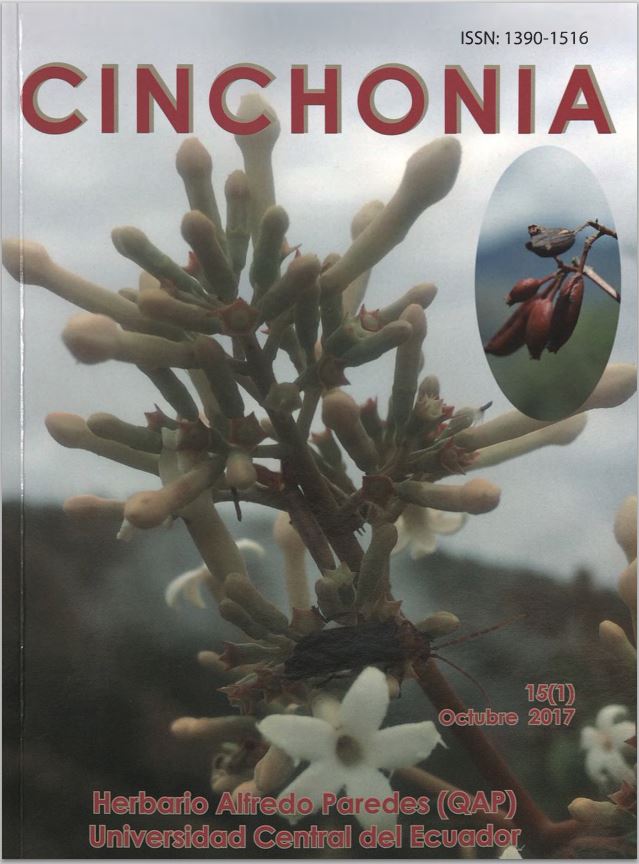Comunidad Fitoplanctónica del Río Topo, Tungurahua-Ecuador
Abstract
The present study is a descriptive one, the same one that was carried out in January 2012. The objective of the study was to determine the phytoplankton component in the riparian zone of Río Topo in the section corresponding to Baños Canton, Río Negro Parish. Four sampling points located in the area of direct influence of the “Hidrotopo” Hydroelectric Project, named: Point 1 “Engine room”, point 2 “Unloading”, point 3 “Before the water intake” and point 4 “After the water intake”. The 128 collection of samples was done by means of stone scraping and filtration. In the laboratory, the 10-mL concentrated sample scanning technique was applied with nine repetitions per point. The samples are in the Laboratory of Microbiology of the Natural and Environmental Sciences, Biology and Chemistry major of Central University of Ecuador. After the analysis, a total of 946 individuals were grouped in 37 genera, 29 families, 19 orders and 5 divisions. The most representative division corresponds to Bacillariophyta, with 424 individuals distributed in 9 orders, 12 families and 15 genera. According to the Shannon-Wiener Diversity Index, the water body is located in the High Diversity category except the “Discharge” point, and a low similarity between the monitored stations is determined via the Sorensen Similarity Índex. When comparing the Topo River with the Pilaló River, it is determined that the number of genera are not dissimilar. Therefore, a total of 42 is recorded in the Pilaló River and a total of 37 in the Topo River. Of the dominant genera, four Genera are common to both bodies of water, and according to Sorensen’s Similarity Index the value is 58%.
References
(1999). Standard Methods for the Examination of Water and Wastewater.
Recuperado de http://www.mwa.co.th/
download/file_upload/SMWW_1000-
3000.pdf (11-jul-2016).
Andrade, C. (1993). Compilaciones: II
Curso Internacional de Limnología
con el tema “Zooplancton y Macroinvertebrados, con Énfasis en el Norte
de Suramérica“. Universidad Técnica
del Norte. Facultad de Ingeniería en
Ciencias Agropecuarias y Ambientales 2008.
Benítez Carranco, M. B. (2013). Evaluación de la Calidad de Agua y Riesgo
de Contaminación del Embalse el
Azúcar en Época en Verano. (Tesis
de pregrado)
La Hora. (2009). El Río Topo en Dilema Ambiental. Recuperado de http://
lahora.com.ec/index.php/noticias/
show/909769/-1/El_r%C3%ADo_
Topo_en_dilema_ambiental.html#.
WJuU22_hDIU (08-feb-2017).
Plataroti, M. (2010). Caracterización de
la Calidad del Agua de una Sección
del Río Luján: Efectos sobre el Fitoplancton. Seminario de Licenciatura
en Ciencias Biológicas Departamento de Ecología, Genética y Evolución
Facultad de Ciencias Exactas y Naturales. Universidad de Buenos Aires –
Argentina.
Pedraza-Garzón, E. & Donato-Rondón,
J. (2011). Diversidad y Distribución de
Diatomeas en un Arroyo de Montaña
de los Andes Colombianos. Caldasia, 33(1), 177-191.
Ponader, K.C. and M.G. Potapova. 2006.
Diatoms from the genus Achnanthidium in flowing waters of the Appalachian Mountains (North America):
Ecology, distribution and taxonomic
notes. Limnologica 37: 227-241.
doi: http://dx.doi.org/10.1016/j.limno.2007.01.004
Universidad Tecnológica Equinoccial.
Recuperado de file:///C:/Users/
MAVE/Downloads/53335_1%20(1).
pdf (28-10-2016).
González, A. (1988). Plancton de las
Aguas Continentales. Escuela de Biología. Facultad de Ciencias. Universidad Central. Caracas.
Maila Álvarez, M.V. y Pérez Alarcón, E.Y.
(2012). Estudio Preliminar del Componente Biológico Planctónico de Pasivos Mineros en la Micro-Cuenca del
río Pilaló, Pujulí-Cotopaxi. Cinchonia,
14(1), 151 - 170.
Ministerio del Ambiente del Ecuador.
(2012). Sistema de Clasificación de
los Ecosistemas del Ecuador Continental. Subsecretaría de Patrimonio
Natural. Quito. Recuperado de http://
www.ambiente.gob.ec/wp-content/
uploads/downloads/2012/09/LEYENDA-ECOSISTEMAS_ECUADOR_2.
pdf (3-ago-2016).
Novelo, E. (2012). Flora del Valle de Tehuacán-Cuicatlán. Bacillariophyta.
Universidad Nacional Autónoma de
México, Instituto de Biología. Recuperado de http://www.ibiologia.unam.
mx/barra/publicaciones/floras_tehuacan/2013/F102_Bac.pdf (23-feb2016).
Pinilla, G. (2000). Indicadores Biológicos en Ecosistemas Acuáticos Continentales de Colombia. Compilación
Bibliográfica. Fundación Universidad
de Bogotá Jorge Tadeo Lozano. Edit.
Litográficas Pabón, Bogotá.
Ramírez, J. (2000). Fitoplancton de Agua
Dulce: Bases Ecológicas, Taxonómicas y Sanitarias. Colombia. Editorial
Universidad de Antioquia. Medellín-Colombia.
Streble, H. y Krauter, D. (1987). Atlas de
los Microorganismos de Agua Dulce:
La Vida en una Gota de Agua. Omega. Barcelona-España.
Tapia, M.E. y Naranjo, C. (2014). Plancton Continental en el Río Napo Ecuatoriano Durante Abril de 2010. Acta
Oceanográfica del Pacífico, 19(2),
89 – 104. Recuperado de http://
www.oceandocs.org/bitstream/handle/1834/8247/Plancton%20continental%20en%20el%20R%C3%ADo%20
Napo%20ecuatoriano,......pdf?sequence=1 (28-10-2016)
Netgrafía
Fotografía y Biodiversidad (2015) Biodiversidad Virtual. Recuperado de
http://www.biodiversidadvirtual.org/
(Feb-2016).
Kinross, J. (2000). The Algal Web. Recuperado de http://www.algalweb.net/
(Feb-2016).
MapasEcuador.net. (2016) Mapas Ecuador. Recuperado de http://www.mapasecuador.net/mapa/mapa-tungurahua-mapa-ubicacion-territorial.html
(08-ago-2016).
Soken – Taxa & JST (1995-2016). ProtistInformaticon Server. Recuperado de
http://protist.i.hosei.ac.jp/ (Feb-2016).


